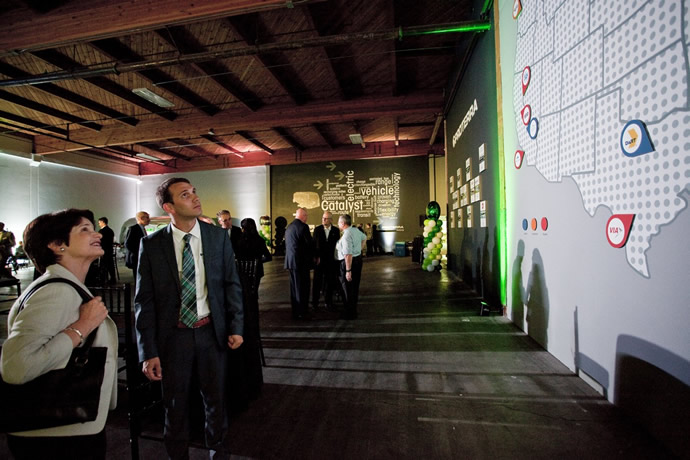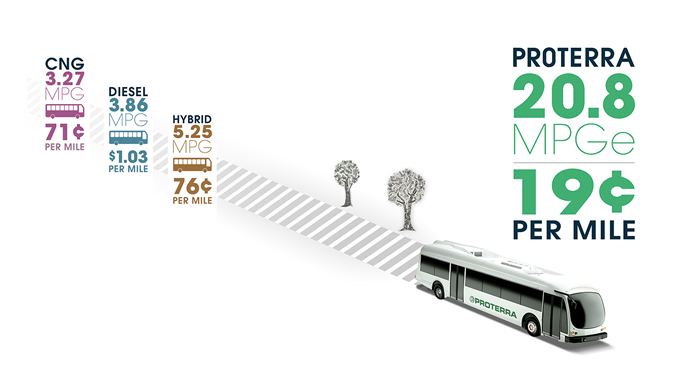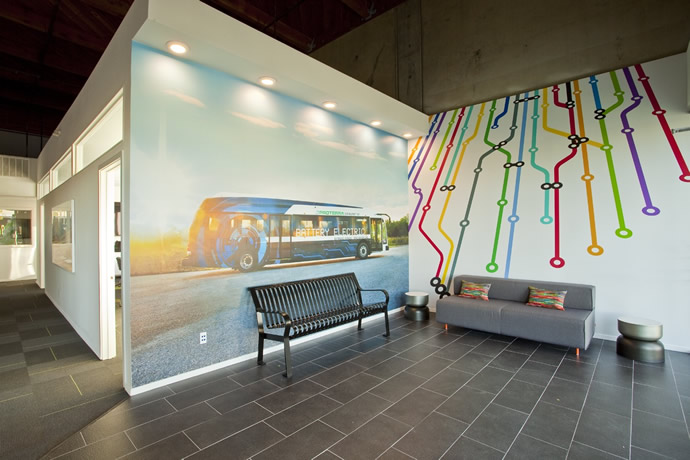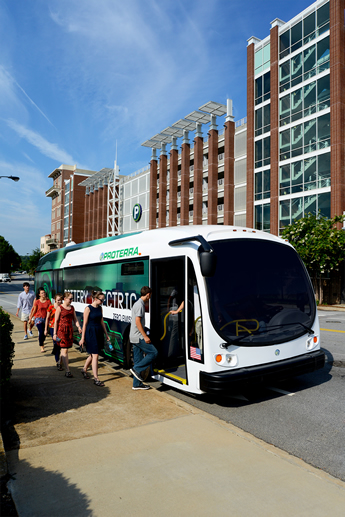In February 2010, electric bus maker Proterra, then based in Colorado, announced it had chosen Greenville, S.C., as the location for a $68-million R&D and manufacturing investment. The presence of the Clemson University International Center for Automotive Research (CU-ICAR), an industry-driven knowledge and innovation coalition, was a big factor in the selection, which came after evaluating sites in 30 states. Proterra aimed to create up to 1,300 jobs over seven years.
Nearly six years into that time frame, the company — which moved its headquarters from Golden, Colo., to Greenville in 2011 — has made bold moves driven as much by policy-driven markets as by market-driven policies. In October, Proterra announced the opening of a new corporate headquarters in the Silicon Valley municipality of Burlingame, Calif.
The 34,440-sq.-ft. (3,200-sq.-m.) Burlingame headquarters will include a mix of management and support teams from the company’s Advanced Engineering, Finance, Sales, Marketing, and HR departments, with 40 employees initially.
“The US is in the midst of a complete reinvention of how we transport people and cargo, and Silicon Valley is at the center of innovation in new powertrains and energy storage systems,” said Ryan Popple, the former Tesla finance executive who is CEO of Proterra. “As younger generations forgo car ownership and cities demand clean and quiet transit solutions, our goal is to help pioneer this movement.”
Driven by increasing urbanization and strict air quality regulations, California is leading the transition to electric mass transit. With the 2016 opening of Proterra’s new Southern California manufacturing facility in City of Industry (announced last spring), Proterra is expected to double its production capacity.
Matt Horton, senior vice president of sales and marketing at Proterra, led the headquarters relocation process at the request of Popple.
“It sounds like a strange request of a sales and marketing professional,” Horton admits in a phone interview, “but I was the CEO of my last company, and led moves three different times. And being a Bay Area local, I had a lot of background in Bay Area real estate, the dynamics for commutes and the population centers and talent base.”
A sales engineer with facilities management experience for the company and a marketing colleague with engineering credentials worked with Horton internally, and the trio worked with external firm DTZ.
“For the headquarters office, we knew we needed to be in Silicon Valley for a variety of reasons,” Horton says. “The state is largest transit market in the US, so it’s important for us to be close to the customers. Most importantly, Silicon Valley really is the nerve center of EV [electric vehicle] technology at this moment. In terms of the talent we wanted to attract with experience in EV programs, this was absolutely the place for us to be as we look to build out our advanced technology development team here, colocated with the headquarters office.”
BART is Smart
Access to transit options for employees was a big driver for this transit company.
“We honed in quickly on this area as we looked at various places in the Bay Area and the San Francisco peninsula,” Horton says. “One reason for that was we wanted to make sure we had really good access to public transit. One of the most important considerations for us, as a public transit company, was the Millbrae BART transit station, which is very close, with access to SFO [San Francisco International Airport]. We took that central point as our primary focus. We wanted to be in close walking distance to transit. We started to search within a quarter-mile radius of that location, and began to look at properties.”
Situated on an estate formerly owned by Darius Ogden Mills, Millbrae’s BART station is the largest intermodal transit terminal west of the Mississippi, featuring a cross-platform connection to Caltrain. But access doesn’t necessarily translate to affordability. An end-of-year office outlook from JLL pegged San Francisco’s office market at a low 8.2-percent vacancy rate, as the metro area combined with Chicago, L.A., Phoenix and Philadelphia to add more than 6.7 million sq. ft. of occupancy during the fourth quarter of 2015 alone, representing nearly a third of the entire nation’s leasing volume.
Cushman & Wakefield reported that among the top 10 strongest markets in terms of rent growth in 2015 were San Jose, with 20.3-percent year-over-year rental appreciation; San Mateo County (12.1 percent); and San Francisco (11.9 percent). So another criterion important to Proterra rose to the fore.

“With Bay Area property being so expensive, we wanted to find an industrial facility that could provide plenty of space for our research tem to spread out, and plenty of blank canvas to build out Silicon Valley–appropriate office space,” Horton says. “We ended up finding the perfect facility here on Rollins Road.”
The building, now in the midst of a phase-two buildout of R&D space, had been used largely as a warehouse for furniture and medical goods. In the process, some of its architectural beauty had been buried by functionality.
“We found when we went in that the building on the interior has a gorgeous roof, all wood,” Horton says. “It’s quite old, and the prior tenants had completely covered it up with a low, awful drop ceiling and bad lighting. We ripped all of that out, and exposed this beautiful ceiling.”
Horton says it’s been a preference for Proterra and his previous companies to have a blank canvas to work with, so that team members can make it their own, and surround themselves with brand touchstones.
There is plenty of space for all the activities we’ll be doing here. It took a lot of vision to see through what was there and what it could be.”
Business Basics
What will become of that Palmetto State base? Horton says the site is close to 200 employees today, and still operates like a scrappy startup.
“We’re trying to maintain that innovative DNA,” he says. “Greenville has been a fantastic location for us. We do a ton of engineering work there, and built a great manufacturing facility there that we’re very proud of. It will remain a vibrant engineering and manufacturing center. We do not plan to move many jobs to California from Greenville. What we have [there] is working quite well, and we want to continue to invest in that market.”
Though CU-ICAR “is a great spot to get good engineering talent from Clemson and other schools,” he says, some components of the company’s advanced battery engineering work will be shifted to the Bay Area, where specialized hiring is ongoing.
But driving that hiring is one thing: Business development. And driving much of that business development is policy.
Last April, the California Energy Commission awarded a $3-million grant to Proterra to fund its 70-job manufacturing line in California. During the grant term, Proterra plans to manufacture an estimated 424 buses. Proterra was the only bus provider selected for CEC funding, and announced on the same day that existing customer Foothill Transit in L.A. County had placed another order for additional Proterra buses to meet increased demand from its ridership base.

“California continues to be a dynamic center for innovation and business opportunities due in part to advanced transportation manufacturers like Proterra,” said GO-Biz director Kish Rajan. “Furthermore, innovations like Proterra’s zero-emission transit buses support the state’s goal of achieving 1.5 million zero-emission vehicles on California’s roadways by 2025.”
“Ultimately, implementing the California Zero-Emission Public Transit Bus Manufacturing Project will help further lower production costs, reduce the upfront cost of zero-emission buses and provide a strong spark to accelerate widespread deployment and adoption,” Proterra stated in April. “The project will accelerate private investment in California, bringing in $5,411,352 in private investment to match the $3,000,000 Energy Commission investment, for a total project budget of $8,411,352.”
“For decades, California has been a consistent leader on policy for the advanced transportation technologies that are now ushering the second wave of adoption for zero-emission transit options like ours,” said Proterra CEO Popple.
“This is the second company I’ve been involved with moving its headquarters from from out of state into California,” says Horton, “and it’s been largely driven by having the right policy environment, whether incentives or favorable programs to encourage clean energy development. The second is proximity to customers — in some cases the state actually acting as a customer. Yes, there will be some businesses that will continue to leave the state, but there are an awful lot of companies attracted to the state from outside, and which have grown here. It feels to me like more of a rebalancing. California may be losing some of the traditional extractive fossil fuel industry companies, but creating absolutely an environment for what I believe is the future of energy. It creates turmoil in that rebalancing, but California is going to be clean and more sustainable in the future, and companies that create that are going to be creating a lot of jobs going forward. It’s a smart strategy.”
‘Interesting Moment’
Faraday Future’s site selection team for a new EV manufacturing complex, like many, found California’s business environment for manufacturing too challenging to overcome. But in addition to business-friendly local government officials in the San Gabriel Valley and an available former Graybar distribution facility, Proterra’s unique product and circumstances made City of Industry just right.
“We manufacture vehicles very differently than a traditional steel bus maker would,” Horton explains. “We start with an all-composite body. Unlike others, we don’t have heavy stamping and tooling requirements, so in some respects our manufacturing is more akin to an assembly facility. We have the ability to have a lot fewer labor hours in each finished bus we build, relative to somebody building a steel bus. We do have a need for very skilled labor, but less than you might expect. California, even with higher labor rates, is still a very compelling place to be from a manufacturing standpoint.
Logistics was another motivator. Costs to ship a finished bus from Greenville to all those West Coast customers can add up to as much as $10,000 per vehicle.

“With so much demand from California and the western states, we save so much from shipping alone,” Horton says. “Proximity to customers is so critical, not only for shipping. We are looking for feedback, and want to be close to them. If you had to pick the largest concentration of transit assets, the LA Basin is about the best you can find in the country.”
What Horton calls the “massive” North American market is the gold standard when it comes to bus transit, and where the company is exclusively focused. “Once we’ve perfected the vehicle here and driven the cost down, we’ll be looking at other markets outside North America.”
Asked if the company’s leaders feel like a mega-regional mobility ecosystem is taking shape across California and neighboring states such as Nevada welcoming such investors as Proterra, Tesla, Faraday Future, Apple and others, Horton says, “We absolutely do.” Exhibit A is Tesla’s lithium-ion battery Gigafactory in Nevada.
“That facility coming online really helped drive innovation and lower prices for batteries, and touched off something of an arms race,” he says. “It will have good benefits for all the EV manufacturers. It really has created a massive magnet for talent such as drive-train engineers coming here from all over the West.
“We are in this very, very interesting moment in the transportation space,” he continues. “Whether Detroit or European or Asian manufacturers, they’re quickly getting on the EV bandwagon. There is a lot of work on autonomous and connected vehicles. And then there are Uber, Lyft, and other on-demand transportation options. There is so much software innovation and interesting hardware work going on at the same time.
That makes Silicon Valley a “very fertile ecosystem for EV innovation,” he says. “It was a big part of our decision to move here. All of the automakers globally are setting up Silicon Valley EV teams. It’s a very fun time to be in this geography.”

